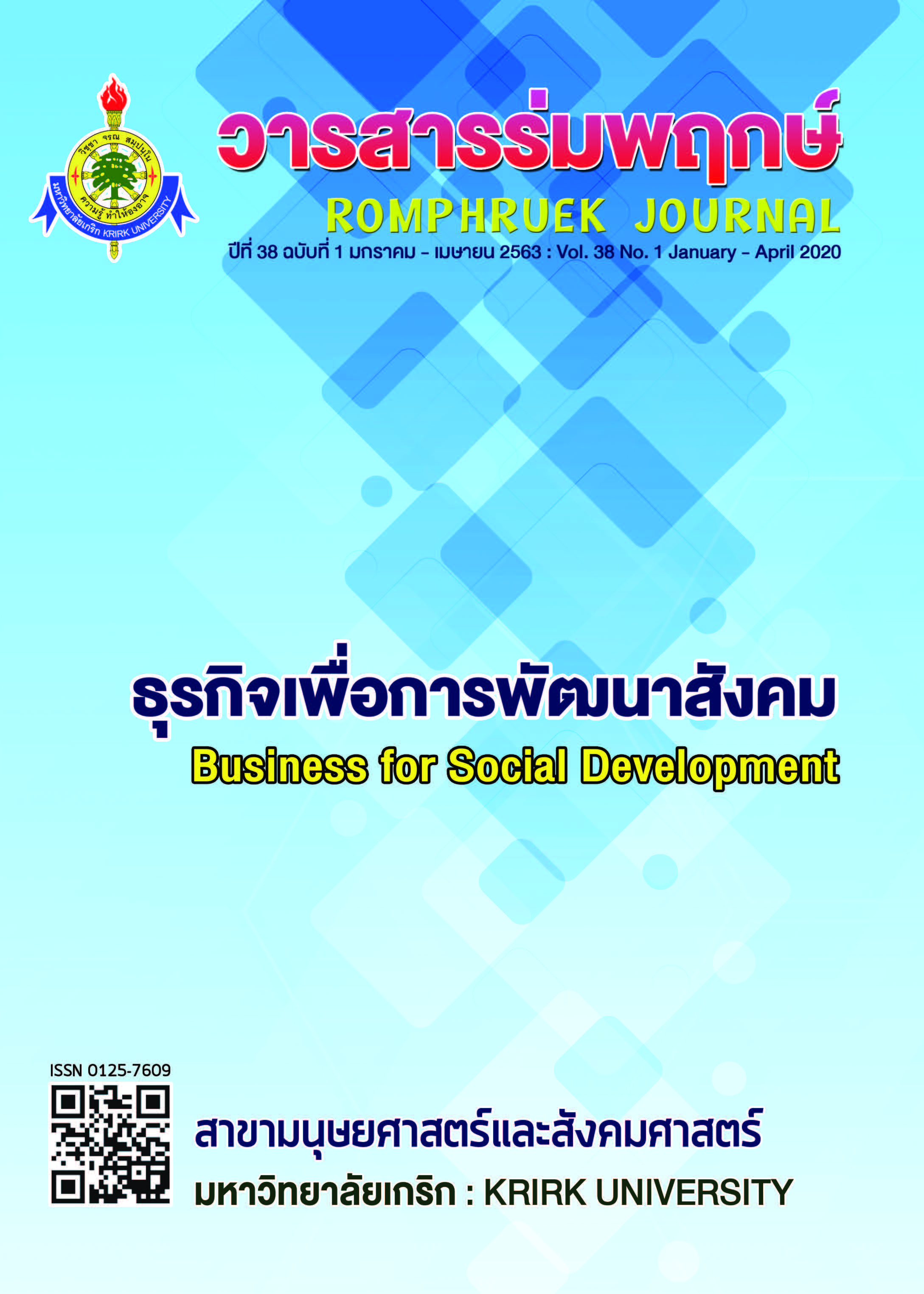Intrinsic Control by Invisible Hand : Economic Incentive of Rape Causes in China
Main Article Content
Abstract
The objective of this article is to analyze the incentive causes of rape crime with the perspective of economy in China. Utilized and integrated many official Statistics and Reports, states that mainly economic phenomena play the role on rape crimes: During economic migration, peasant workers have aggravated sexual repression, who became a highly concerned potential rape crime group. Under heavy economic burden, delayed marriage age, falling marriage rate and rising divorce rate had led to prolonging asexual period for the young blood. With infections of economic exploitation, the celebrities’ sexual games have diffused imitation effects, while the poor’s sexual helpless will accelerate the social frustration and masculinity loss which cannot compensate the sexual psychology development healthily.This article proposes that lessons from Franz von Liszt’ Criminology Theory, social policy represents the best and effective crime policy, deduces thesolutions including Poverty Alleviation Policy and Reducing Gap in Wealth Policy which maybe reduce the occurrence rate of rape in China. These best economic policies will be able to loosen the hand which halted necks of those souls’ libido.
Article Details
Every article published in the Romphruek Journal of the Humanities and Social Sciences is the opinion and point of view of the authors. Thery're not the viewpoint of Krirk University or the editored department. Any part or all of the articles for pablication must be clearly cited.
References
Affairs, C. C. (2019). Statistical Yearbook. (2019,11 May) Retrieved from https://tongji.cnki.net/.
Bourgois, P. (1996). In search of masculinity : violence, respect and sexuality among Puerto Rican
crack dealers in East Harlem. The British Journal of Criminology, 36(3), 412-427.
Bureau, N. S. (2018). National Economic and Social Development Statistics Bulletin.
(2019, 2 May) Retrieved from https://www.stats.gov.cn/tjsj/zxfb/201902/t20190228_1651265.html.
Center, G. G. G. S. E. (2017). The Survey on Sexual Harassment in Chinese universities.
(2019, 21 March) Retrieved fromhttps://posts.careerengine.us/.
Chancellor, A. S. (2012). Investigating Sexual Assault Cases. Massachusetts,
U.S.A. : Jones & Bartlett Publishers.
China, M. O. C. A. O. T. P. S. R. O. (2017). statistical bulletin on social service development.
(2019,18 March) Retrieved from https://www.mca.gov.cn/.
Chitnis, V., & Wright, D. (2007). Legacy of Colonialism : Law and Women's Rights in India.
Wash. & Lee L. Rev., 64, 1315.
Cormack, L. (2018). The Sydney Morning Herald is Newspaper from Sydney, Australia.
(2018, 9 November) Retrieved from https:// www.smh.com.au/national/nsw/yunxiang-gao-china-s-hugh-jackman-to-face-7-new-charges-over-sex-assault-20181108-p50euu.html.
Daily, H. (2018). A group of 56 professors has called for severe punishment of sexual harass- ment
in universities. (2019, 2 April) Retrieved from https://www.syiptv.com/article/show/ 27115.
Daily, T. P. S. (2018). The Chinese marriage data in 31 years : Young people are marrying later, and
the divorce rate has risen for 15 years in a row. (2019, 16 June) Retrieved from
https://www.weibo.com/rmrb?is_hot=1.
DRC, R. T. O. (2015). Research Report on China’s Livelihood Index. Beijing : Peking University Press.
Freud, S. (1954). The Interpetation of Dreams,edited and translated by J.
Strachey. In : London : George Allen and Unwin.
Gallo, C., & Kim, M. E. (2016). Crime policy and welfare policy. Oxford Handbook Online, 171.
Garrett, T. A. (2008). US income inequality : it's not so bad. The Regional Economist, (Oct), 4-5.
Gini, C. (1997). Concentration and dependency ratios. Rivista di politica economica, 87, 769-792.
Guangyou Li, F. Y. (2009). Analysis on the mental state and suicidal tendency of left-behind
children aged 14-16 years. Chinese Journal of Public Health, 25(8), 905-907.
Hernández, J. C. (2019). She’s on a # MeToo Mission in China. (2019, 4 June) Retrieved from https://www.nytimes.com/2019/01/04/world/asia/china-zhou-xiaoxuan-metoo.html.
Hong, K. (2018). A New Mens Rea for Rape : More Convictions and Less Punishment. Am. Crim.L. Rev., 55, 259.
Hsu, T. (2019). JD.com’s Chief, Richard Liu, Is Accused of Rape in Lawsuit. (2019, 15 May) Retrieved from https://www.nytimes.com/2019/04/16/business/jdcom-ceo-richard-liu-rape-lawsuit.html.
Information, U. N. D. O. P. (2015). Millennium Development Goals Report 2009.
Includes the 2015 Progress Chart : United Nations Publications.
Institute, C. B. R. (2017). The Report on Professions of Sexual Infidelity. (2019, 11 May)
Retrieved from https://www.askci.com/reports/.
Jewkes, R. (2002). Intimate partner violence : causes and prevention. The lancet. 359(9315), 1423-1429.
Jie, Z. (2018). The Historic Achievements of targeted poverty alleviation program in past five years.
China Daily, 2018(6), 23.
Korajczyk, R. A., & Levy, A. (2003). Capital structure choice : macroeconomic conditions and
financial constraints. Journal of financial economics, 68(1), 75-109.
Piven, F. F., & Cloward, R. (2012). Poor people's movements : Why they succeed. How they fail : Vintage.
Saunders, C. J. (2001). Rape and ravishment in the literature of medieval England.
Suffolk, England : Boydell & Brewer.
Science, B. D. O. L. (2019). Big data analysis platform for law science and technology. (2019, 18 May)
Retrieved from https://www.gtcom.com.cn/en/index.php?c=yeesight&a=index.
Smith, A. (2010). The theory of moral sentiments. London, U.K. : Penguin.
Susan Faupel, M. S. W. (2015). Etiology of Adult Sexual Offending. (2019, 16 March)
Retrieved from https://www.smart.gov/SOMAPI/sec1/ch2_etiology.html.
Von Liszt, F. (1905). Strafrechtliche Aufsätze und Vorträge. J. Guttentag. (Vol.1), 211.
Webster, T. (2012). China's Human Rights Footprint in Africa. Colum. J. Transnat'l L., 51, 626.
Wenwei, Z. (2007). The Report on Sexuality of Migrant Workers. Chinese Journal of Human Sexuality, 8, 7-16.
Xijin, H. (2019). The comments on Richard Liu’s sexual assault case : Chinese entrepreneurs must
keep a low profile. (2019, 1 May) Retrieved from
https://k.sina.com. cn/ article _6440518907_ 17fe284fb00100gznj.html?from=job.
Xinhua, J. (2007). The latest survey report on migrant workers in China.
Chinese Population Resource and Environment, 17, 1-8.
Xinwen. (2008). A nationwide survey of left-behind children in rural areas.
Chinese Journal of Reproductive Health, 19(4), 232.
Zhenai.com. (2018). Survey report on the single population in 2018. (2019, 8 June)
Retrieved from https://36kr.com/p/5148641.


